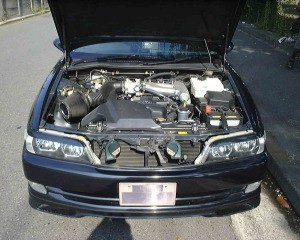
Engine 1JZ-GE
 The 1JZ-GE engine can be safely called a legend created by the designers of the Japanese company Toyota. Why a legend? The 1JZ-GE was the first engine in the new JZ range created in 1990. Now the engines of this line are actively used in motorsport and in ordinary cars. 1JZ-GE became the embodiment of the latest technologies of that time, which are still relevant today. The engine has established itself as a reliable, easy to operate and relatively powerful unit.
The 1JZ-GE engine can be safely called a legend created by the designers of the Japanese company Toyota. Why a legend? The 1JZ-GE was the first engine in the new JZ range created in 1990. Now the engines of this line are actively used in motorsport and in ordinary cars. 1JZ-GE became the embodiment of the latest technologies of that time, which are still relevant today. The engine has established itself as a reliable, easy to operate and relatively powerful unit.
Specifications 1JZ-GE
| Number of cylinders | 6 |
| Cylinder arrangement | in-line, longitudinal |
| Number of valves | 24 (4 per cylinder) |
| Type | petrol, injection |
| Working volume | 2492 sm3 |
| Diameter of the piston | 86 mm |
| Piston stroke | 71.5 mm |
| Compression ratio | 10:1 |
| Power | 200 h.p. (6000 rpm) |
| Torque | 250 N * m (4000 rpm) |
| Ignition system | Timer |
First and second generation
As you can see, the toyota 1JZ-GE is not turbocharged and the first generation had distributor ignition. The second generation was equipped with coil ignition, 1 coil was installed for 2 candles, and a VVT-i valve timing system.

1JZ-GE vvti - the second generation with variable valve timing. Variable phases allowed to increase power by 20 horsepower, smooth out the torque curve, and reduce the amount of exhaust gases. The mechanism works quite simply, at low speeds the intake valves open later and there is no valve overlap, the engine runs smoothly and quietly. At medium speeds, valve overlap is used to reduce fuel consumption without losing power. At high RPMs, VVT-i maximizes cylinder filling to increase power.
The first generation engines were produced from 1990 to 1996, the second generation from 1996 to 2007, they were all equipped with four and five-speed automatic transmissions. Installed on:
- Toyota Mark II
- Mark II Blit;
- Chaser;
- Crest;
- Progress;
- Crown.
Maintenance and repair
JZ series engines work normally on 92nd and 95th gasoline. On the 98th, it starts worse, but has high productivity. There are two knock sensors. The crankshaft position sensor is located inside the distributor, there is no starting nozzle. Platinum spark plugs need to be changed every XNUMX miles, but to replace them you will have to remove the top of the intake manifold. The volume of engine oil is about five liters, the volume of coolant is about eight liters. Vacuum air flow meter. The oxygen sensor, which is located near the exhaust manifold, can be reached from the engine compartment. The radiator is normally cooled by a fan attached to the water pump shaft.
Overhaul of 1JZ-GE may be needed after 300 - 350 thousand kilometers. Naturally standard preventive maintenance and replacement of consumables. Probably the sore point of the engines is the timing belt tensioner, which is only one and often breaks. Problems can also arise with the oil pump, if it is simple, then it is similar to the VAZ one. Fuel consumption with moderate driving from 11 liters per hundred kilometers.
1JZ-GE in JDM culture
JDM stands for Japanese Domestic Market or Japanese Domestic Market. This abbreviation formed the basis of a worldwide movement, which was initiated by the JZ series engines. Nowadays, probably, most of the engines of the 90s are installed in drift cars, as they have a huge supply of power, are easily tuned, simple and reliable. This is confirmation that the 1jz-ge is a really good engine, for which you can safely give money and are not afraid that you will stop at the side of the road on a long journey ...

